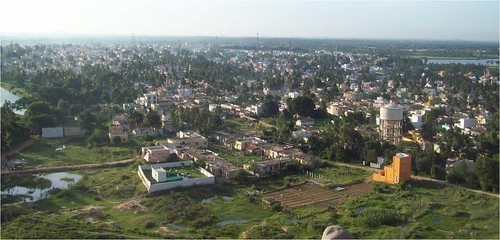Wells and Step-wells
Impact of pit-toilet leachate on groundwater chemistry and role of vadose zone in removal of nitrate and E. coli pollutants in Kolar District, Karnataka, India
Posted on 04 Jan, 2013 02:00 PMGiven the many problems associated with flush toilets and the sewerage system, pit toilets offer a viable solution in India. However, the use of soakpits raises the question of groundwater contamination. This paper assesses the impact of pit toilet leachate on groundwater quality in Mulbagal town (pop ~ 60,000) in Karnataka relies on pit toilets, and uses groundwater for drinking.
Highlights from the 10-year water policy research programme of the International Water Management Institute and the Sir Ratan Tata Trust discussed at the IWMI - TATA Annual Partners' Meet at Anand, between 28-30 November, 2012
Posted on 05 Dec, 2012 02:06 PMIWMI-Tata water policy research programme is a collaborative initiative between the International Water Management Institute (IWMI) and the Sir Ratan Tata Trust (SRTT).
Dugwell - An asset for sustainable livelihood: An Arghyam and Action for Social Advancement (ASA) project carried out in 2 tribal bocks of Ratlam district in Madhya Pradesh
Posted on 27 Oct, 2012 10:44 AMAt the same time we also need to keep in mind the judicious use of natural resources, especially in rain-fed areas. Integrating sustainability and demand is one of the greatest challenges faced by communities and nations today.
Bacterial contamination in water affects more than half of Chennai
Posted on 09 Oct, 2012 03:44 PMChennai formerly known as Madras, the capital of Tamil Nadu is the sixth most populous city in India with 4.68 million residents as of 2011. Until 1870, it had no piped water supply within the city and people were dependent on public and private wells. The construction of a piped water supply system was started in 1872. This laid the foundation for the present water supply system.

Dug wells- A potentially safe source of drinking water for the arsenic and iron contaminated region of Bihar - A paper by Megh Pyne Abhiyan (MPA)
Posted on 03 Aug, 2012 01:00 PMThis paper published by Megh Pyne Abhiyan argues that dug wells slowly started losing their significance following the invention and large scale marketing of hand pumps,.
Tenda, a traditional system to draw water from open wells that is still practiced even today in Chattisgarh and Odisha
Posted on 05 Jun, 2012 10:00 PMTwo talukas, Jat & Atpadi, in Sangli district of Maharashtra face worst drought despite river Krishna flowing just 100 kms away
Posted on 05 Jun, 2012 02:09 PM
National Environmental Engineering Research Institute seeks opinion from the public on the concept of groundwater recharge with treated municipal wastewater
Posted on 09 Mar, 2012 02:24 PMGuest post by: Anisha Nijhawan
Photo exhibition on open wells and groundwater, Goethe-Institut, March 22, 2012, Bangalore
Posted on 05 Mar, 2012 12:05 PMOrganizer: Goethe-Institut/Max Mueller Bhavan Bangalore
Venue: Goethe-Institut/Max Mueller Bhavan Bangalore,
716 CMH Road,
Indiranagar 1st Stage,
Bangalore 560 038

The Goethe-Institut/Max Mueller Bhavan Bangalore, offers language courses, organises cultural events and has a Library. We determine our main areas of interest in consultation with our Indian cooperation partners from the fields of art, science and media, from NGOs and select companies, with whom we jointly develop appropriate programmes and projects. Our activities range from film screenings, exhibitions, theatre performances and concerts to workshops and conferences particularly on innovative topics such as video and media art.
Water resource accounting as a tool for urban water management - An illustration in NCT- Delhi - Journal of Indian Water Works Association
Posted on 24 Feb, 2012 10:41 PMThe paper discusses the natural resources accounting in the context of national/regional policy first, and then places water resource accounting within it. Subsequently, the methodology as well as study framework adopted for resource accounting are discussed.




